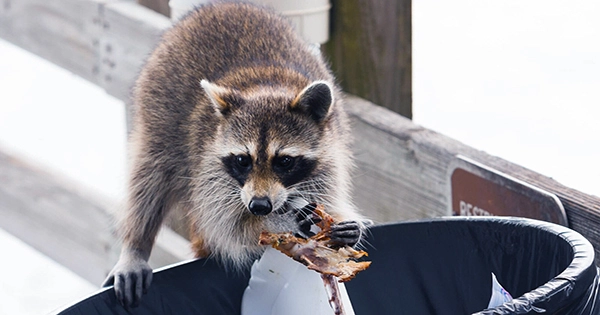The common raccoon had an advanced bandit mask that could compete with the Hamburglar, thus it was almost made for a life of crime. These animals are known for robbing bins and breaking into banks, and they are adept at navigating city life. However, according to recent research, it’s not the brazen raccoons that you need be concerned about when trying to catch the more serious offenders.
Researcher Lauren Stanton of the University of California, Berkeley, in the United States set out to find raccoons in order to better understand the thoughts of a non-human heist artist who lives in urban areas. She intended to identify the cognitive skills that are useful for urban animals through her research and ascertain whether they are associated with any particular sorts of behavior.
Stanton and colleagues successfully captured raccoons in the city of Laramie, Wyoming, using live traps baited with cat food. The fluffy bandits were returned to their lab, where they underwent a health examination before being judged on how fierce or submissive they seemed.
Each raccoon had its temperature and temperament recorded, and a tiny radio frequency ID tag was inserted between each animal’s shoulder blades so the researchers could monitor its activities. They then allowed them to return to their original habitats, but science wasn’t quite done with them.
Further humane traps were set by the researchers, appealing to the raccoons’ propensity for theft and possibly indicating their impulsivity in reporting back to the investigators how many times each raccoon was caught. They kept track of 204 raccoons in this fashion for four years until the real issue arose.
Raccoons were encouraged to participate in their own adaptation of The Cube, where they were given a box to solve a puzzle in exchange for dog biscuits. The ability? the capacity to press the proper button. Please keep in mind that we’re talking about raccoons if you’re thinking, “That sounds incredibly straightforward.”
The erroneous belief that they would show up in a planned manner was one of the unintended consequences of the raccoon challenge pods. The popularity of the raccoon boxes occasionally drove the raccoons crazy, making them shake and bump the box as one poor animal tried to figure out what to do.
Fortunately, not every test session ended in total pandemonium, and the team was still able to collect information on which animals learned it the fastest. The researchers then flipped which switch released the incentive to further put their subjects’ cognitive abilities to the test.
The findings showed that 27 raccoons had mastered The Cube after two years. 19 attendees discovered which switch would reward them with delectable biscuits, and 17 managed to manipulate the switches. Finally, there was the big revelation.
It appeared that the calmer raccoons were the more cunning when comparing the minds of The Cube to their emotional temperaments. This, according to Stanton, may indicate that raccoons’ cognitive capacity and emotional sensitivity are related.
It might also mean that chasing after the brazenest, boldest raccoons might make matters worse in terms of keeping these fluffy bandits away from bins and banks, leaving behind the cool-headed real criminal masterminds.
















